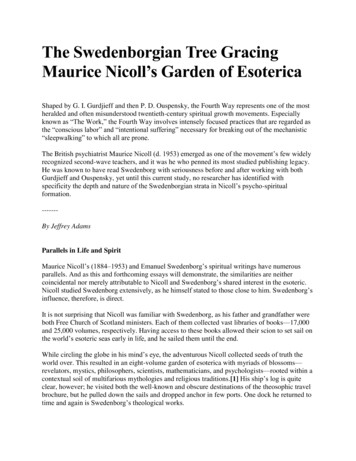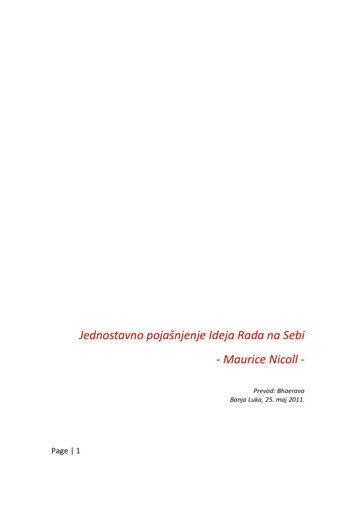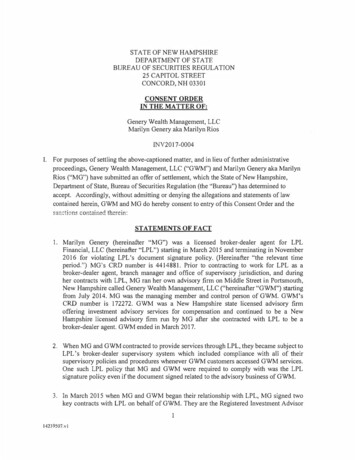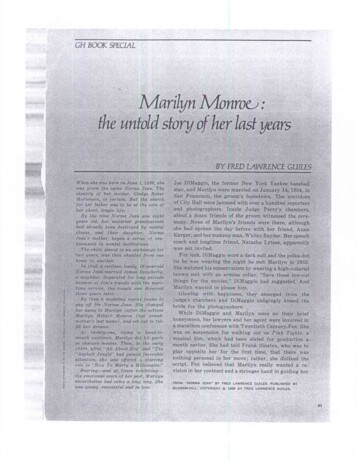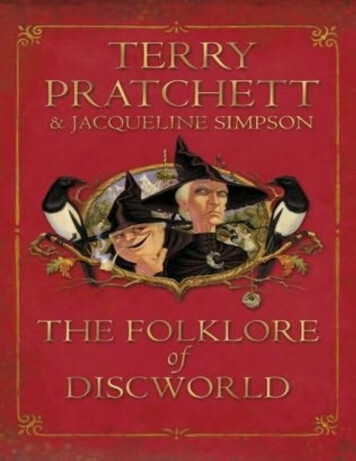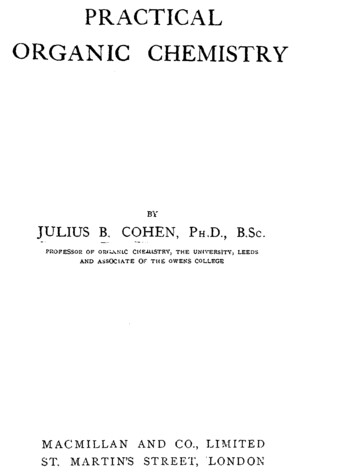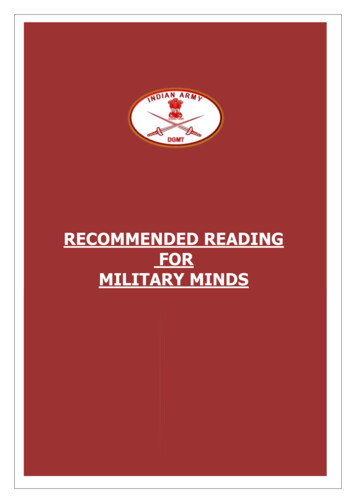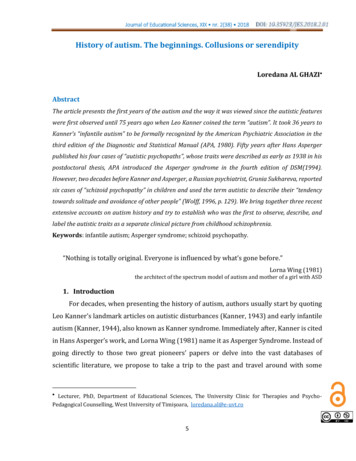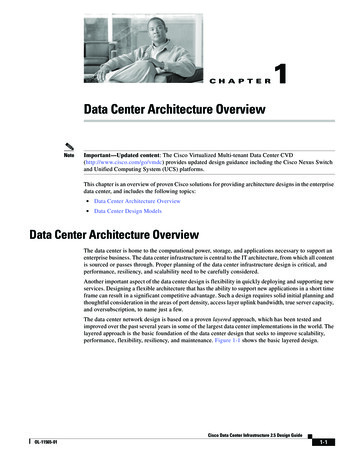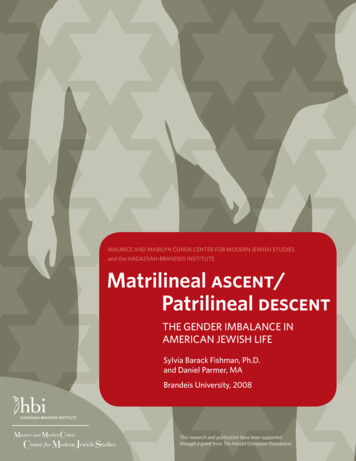
Transcription
MAURICE AND MARILYN COHEN CENTER FOR MODERN JEWISH STUDIESand the HADASSAH-BRANDEIS INSTITUTEMatrilineal ascent/Patrilineal descentTHE GENDER IMBALANCE INAMERICAN JEWISH LIFESylvia Barack Fishman, Ph.D.and Daniel Parmer, MABrandeis University, 2008This research and publication have been supportedthrough a grant from The Harold Grinspoon Foundation
Gender Imbalance in American Jewish LifeTable of ContentsList of Tables and Figures . iiiIntroduction: What Is Gender Imbalance, and Why Is It a Problem? . 1Is Feminization of Religion ―Natural‖ or Inevitable? . 2The Problem Is ―Patrilineal Descent‖—Not ―Matrilineal Ascent‖. 4The Other Jewish Gender Imbalance: Traditional Exclusion of Women . 6Studying Gender Imbalance and Its Implications . 7Triangulating Numbers, Interviews, and Cultural Context . 9One: Distinctive Jewish Gender Roles and How They Changed. 12Historical Jewish Societies Reserved Public Religious Roles for Men . 14Women as Historical Brokers for Modernization . 17The 1960s Challenge Middle Class Mores and American Jewish Patterns . 20Women Recent Brokers for Jewish Rituals, Ceremonies, Liturgical Skills . 22Cultural Explorations of Jewishness Often Led by Women, or by Men Trained inOrthodox Settings . 27Two: Gendered Thinking About Judaism in Jewish Homes . 31Relationship with Organized Religion Varies by Marriage Type . 34Women More Likely to Think Religion Is Necessary . 36Men More Likely to See Religion as Unnecessary . 37Who Makes Decisions About Your Child‘s Religion? . 42Beyond the Judeo-Christian Blend: How Unique Is Judaism? . 44How Important Is Being Jewish to You? . 44Three: Doing Jewish—Synagogue and Ceremony as the “World of Our Mothers” 47Religious Observances in Inmarried Families Reflect Judaism and Gender . 52Gender Affects Ritual Observances in Intermarried Families . 53Brit Milah in Inmarried and Intermarried Jewish Households . 56Four: Peoplehood, Social Networks, Israel Attachments . 57Ethnic Social Capital. 57Denominational Differences in Jewish Social Capital. 61Goals for Raising Children and Brokering Jewish Family Connections . 64Jewish Particularism and American Diversity . 66Conclusion: Engendering Jewish Connections . 68Growing Evidence for Gendered Needs . 71Major Research Findings . 75Women . 75Men . 76Men and Women . 76Research and Policy Implications . 77ii
iiiFishman and Parmer, 2008List of Tables and FiguresTable 1: Gender differences among Jews in 51 Nations. 3Figure 1: Inmarried Jewish Parents by Importance of Religion ―Very Important‖ . 40Figure 2: Intermarried Jewish Parents by Importance of Religion ―Very Important‖ . 41Figure 3 Inmarried Jewish Parents in Current Wing of Judaism by Primary DecisionMaker of Child‘s Religion . 42Figure 4: Intermarried Jewish Parents in Current Wing of Judaism by Primary DecisionMaker of Child‘s Religion . 43Figure 5: Inmarried Jewish Parents in Current Wing of Judaism by Importance of BeingJewish ―Very Important‖ . 45Figure 6: Intermarried Jewish Parents by Importance of Being Jewish. 46Figure 7: Inmarried Jewish Parents in Current Wing of Judaism by Frequency ofSynagogue Attendance ―Weekly of More‖. 50Figure 8: Inmarried Jewish Parents by Frequency of Synagogue Attendance ―Never‖ . 51Figure 9: Intermarried Jewish Parents by Frequency of Synagogue Attendance . 52Figure 10: Inmarried Jewish Parents‘ Ritual Observance by Affiliation and Gender . 54Figure 11: Intermarried Jewish Parents‘ Ritual Observance by Wing of Judaismand Gender . 55Figure 12: Intermarried Jewish Parents in Current Wing of Judaism by Brit Milah forMale Child . 55Figure 13: Inmarried Jewish Parents in Current Wing of Judaism by Proportion ofJewish Friends . 59Figure 14: Intermarried Jewish Parents in Current Wing of Judaism by Proportion ofJewish Friends . 60Figure 15: Inmarried Jewish Parents in Current Wing of Judaism by Ever Been to Israel . 62Figure 16: Inmarried Jewish Parents in Current Wing of Judaism by Care About Israel―Very Important‖ . 63
Gender Imbalance in American Jewish LifeIntroduction: What Is Gender Imbalance,and Why Is It a Problem?Three decades ago writer WilliamNovak panicked Americanwomen with gloomy predictionsof The Great American Man Shortage.1A few years later British feministpsychologist Lynne Segal asked, Is theFuture Female?2 Their titles eerilyforeshadowed the fact that todayAmerican Jewish boys and men havefewer connections to Jews and Judaismthan girls and women in almost everyvenue and in every age, from school agechildren through the adult years. Thedescent of male interest is evident notonly in domestic Judaism, as expected,but also in public Judaism, religiousleadership, and secular ethnicattachments. In Fall 2005 womenoutnumbered men two to one in theentering rabbinical class in the Reformmovement‘s Hebrew Union CollegeJewish Institute of Religion (HUC-JIR),for example.3 Nationally, girls andwomen outnumber men in weekly nonOrthodox worship services, in adulteducation classes, in volunteerleadership positions, and in Jewishcultural events. Only in lucrative, highstatus executive positions in the Jewishcommunal world do men outnumberwomen.4Perhaps most disturbingly, Jewishmen rank lower than Jewish women insecular ethnic, social, family orpeoplehood connections as well. As wewill show, Jewish men have measurablylower rates of ethnic and religious socialcapital than Jewish women, ascharacterized by involvement withdistinctively Jewish activities andconnections with Jewish socialnetworks. Ethnic social capital—definedeither by non-religious, secular, or byreligious cultural activities andnetworks—characterizes AmericanJewish women far more than men. Menare less likely to value Jewishness in theUnited States and worldwide as adistinctive culture, and less likely to visitIsrael. Jewish women more than Jewishmen have mostly Jewish friends anddescribe themselves as affiliated withone of the wings of American Judaism.Jewish men have weaker family ties thanJewish women, and are less likely to stayin close touch with Jewish familymembers than Jewish women. Jewishmen are less likely to self-identify with awing of Judaism, and far more thanJewish women call themselves ―secular,―cultural,‖ or ―just Jewish.‖ Men investless of their human capital intoJewishness, as we will shortly discuss.This is a matter of deep concern, becauseminority groups with high amounts ofethnic capital are much more successfulat transmitting their culture to the nextgeneration.The majority of American Jewsespouse equality as an important value,but Jewish life today is not gender equal.When it comes to gender equality or1
2Fishman and Parmer, 2008gender balance, contemporary AmericanJewish life is caught between a rock anda hard place: Traditional public Judaismwas and is dominated by men, whilecontemporary liberal American Judaism,although supposedly egalitarian, isvisibly and substantially feminized.Jewish activities from the broadgrassroots to the elite echelons of liberalJewish religious leadership have becomedevalued, a typical result offeminization. Thus, boys and men as agroup value feminized Jewish activitiesand environments less, and have fewerconnections to Jews and Judaism.Is Feminization of Religion“Natural” or Inevitable?The American Jewish communityhas been slow to react to thefeminization of Jewish classrooms,synagogues, social networks andleadership positions in part becausefemale prominence in cultural andreligious realms seems ―natural‖ on theAmerican scene. A preponderance offemale worshippers is characteristic ofmany American Christian churches, andpopular cultural all-American imageryoften depicts men fishing and watchingfootball games while women attend tochurch business.In social scientific theoreticaldiscussions as well, American scholarshave long asserted that women are more―religious‖ than men through essentialpsychological differences or socialconditioning. ―By now it is so taken forgranted that women are more religiousthan men that every competentquantitative study of religiousnessroutinely includes sex as a controlvariable,‖ Stark articulates thesupposedly universal assumption.5 Whilesome researchers assert innatepsychological leanings are the basis forfemale religiosity, others suggestdifferential socialization creates genderdifferences, arguing: ―men are assigned[by society] roles that are moreinstrumental than socio-emotional andthus are less concerned with problems ofmorality,‖ but women are morerelational in their development and moreinclined toward religiosity.6The theoretical assumption thatwomen are innately more religious thanmen has led scholars and most policymakers to virtually ignore thefeminization of American Jewish life.After all, their attitude seems to be, ifgreater religiosity is universally ―hardwired‖ into women, how can strategiesto increase male involvement make adifference? However, feminization isneither universal nor inevitable, animportant new study shows. Examiningthe intersection of gender and religionaround the world, D. Paul Sullins (2006)uses international data revealing that inreligions other than Christianity—especially Judaism and Islam—men areoften equally or more religious thanwomen. Outside the United States,gendered approaches to religion arediverse. Men, rather than women, areoften perceived as more religious. Mostsalient to our subject, ―Worldwide, thereis no measure of religiousness on whichJewish females
Gender Imbalance in American Jewish LifeTable 1: Gender differences among Jews in 51 NationsJews in World Values Survey (WVS, 1995-97), N 1,183% members synagogue or religious organization Men 63%Women 62%% attending services weekly or moreMen 69%Women 53%% who say religion is important in their lifeMen 87%Women 87%% who believe in GodMen 94%Women 94%% who believe in life after deathMen 78%Women 71%% who call themselves ―a religious person‖Men 91 %Women 93%Source: Adapted from Sullins ―Gender and Religion: Deconstructing Universality,Constructing Diversity‖ American Journal of Sociology (2006, p. 845)score higher than Jewish males. Jewishmen report significantly higher rates ofsynagogue attendance and belief in lifeafter death than do Jewish women;otherwise, there is no sex difference inreligiousness among Jews,‖ Sullinscomments.7If the international evidencedemonstrates that women are notnecessarily more religious than men,why do American social scientistscontinue to produce findings that―women are more religious than men onevery measure of religiosity,‖ as Walterand Davie (1998) put it? Part of theanswer lies in their research bias. Manyrecent studies focus on religious beliefrather than on religious activities. Surveyinstruments are constructed in a waywhich emphasizes—and defines as―religious‖—women‘s psychologicalexpressions of religiosity. Meanwhile,questionnaires typically downplay orignore men‘s more activity-basedexpressions of religiosity. Researchersword questions in ways that direct ―therespondent to ignore attendance atreligious services or ritual—probably themost basic form of participation inalmost all religions—in assessing his orher own religiousness.‖ This researchbias is particularly problematic whenstudying Jewish religious culture, whichtraditionally places enormous emphasison religious activities, and relativelylittle, sporadic emphasis on belief. In thework of such prominent gender andreligion researchers as Stark and Miller,―only affective, personal piety, notinstitutional participation, ritual practice,or the fulfillment of related norms iswhat count as religiousness,‖ as Sullinspoints out.8Gender imbalance regardingreligious activities is not innate. Whengender imbalance occurs in the3
4Fishman and Parmer, 2008American Jewish community it needs tobe studied so that future policies andplans can be based on targeted researchdata.The Problem Is “PatrilinealDescent”—Not “MatrilinealAscent”Gender imbalance is a criticalproblem in American Jewish life notbecause women are more active butbecause men are less active. Men‘sdecreased interest in Jews and Judaismwalks hand in hand with apathy towardcreating Jewish households and raisingJewish children, as well as lower levelsof Jewish education, less synagogueattendance, less organizationalinvolvement, and lower participationboth in Jewish cultural activities andJewish rituals. When dating non-Jewishmen, Jewish women tend to pro-activelydeclare their intention to raise Jewishchildren. Jewish men, in contrast, tend tobe reactive in inter-dating andintermarriage, not talking about thereligion of the household or the eventualchildren until children are born or readyfor religious school. Although rates ofintermarriage are now similar for Jewishmen and women, Jewish men often takethe lead in dating non-Jews, articulatingnegative attitudes toward Jewish women,while Jewish women often turn to nonJewish men in response to the perceivednegativity in men of their own religiousgroup.9The gendered Jewish-connectionsgap between Jewish men and womenmarried to non-Jews is most dramatic intheir reported commitment to raisingJewish children. The 2005 Boston studyindicated that almost nine out of tenJewish mothers married to non-Jewishmen said they intended to raise theirchildren as Jews, compared to about halfof Jewish fathers married to non-Jewishwomen. The families least likely to raiseJewish children are those in which theJewish parent self-describes as―secular.‖ Both local and nationalreports indicate that the fastest growingJewish population that describes itself as―secular,‖ ―cultural,‖ ―atheistic‖ or―agnostic‖ is intermarried Jewish men.10As sociologist Steven M. Cohen remarksabout data from two Synovate/MarketFacts studies, ―women are moreJewishly engaged than men,‖ and thereis ―a relative absence of men‖ in almostall Jewish environments.11Little serious research anddiscussion have been addressed to thecurrent gender imbalance in Jewish life,partially because such analysis can bemisinterpreted as a call for women toretreat from Jewish involvements.Current patterns contradict thousands ofyears of Jewish history, during whichmen were the public and signifyingJews—and during which women wereoften marginalized or shut out oforganized intellectual activities andpublic Judaism. For some, the currentprominence of Jewish girls and womenmight seem to be a simple righting ofmillennia of wrongs. The increasedactivity of women in Jewish milieus alsoseems ―natural‖ because it conforms toAmerican Christian norms of (1)
Gender Imbalance in American Jewish Lifeethnoreligious attachment being definedby spiritual feelings and beliefs, ratherthan by activities; and (2) these spiritualfeelings and beliefs being perceived asessentially female, rather than maleattributes. Thus, the growingfeminization of liberal Judaism has often―slipped under the radar‖ of Jewishcommunal attention because thesepatterns are typical especially amongProtestant populations in the UnitedStates.Some observers have asserted thatthe retreat of men from American Jewishlife does not comprise a problem.12Rabbi Rona Shapiro, among others,strongly asserted in a much-discussedop-ed piece in The Forward (January 5,2007), that the so-called ―Boy Crisis‖ inAmerican Jewish life is a fraud, a kindof ―crying wolf.‖ She asks rhetorically,Thirty-five years ago whenwomen were not ordained as rabbis,when girls in the Conservativemovement celebrated a bat mitzvahon Friday night, when Orthodoxgirls did not receive an educationremotely comparable to that of theirbrothers, when women were notcalled to the Torah for aliyot orallowed on the bimah at all—wherewere the headlines proclaiming agirl crisis?13In fact, thirty-five years ago in theearly 1970s, (as we discuss more fully inChapter One) Jewish feminists in theUnited States and Israel were doingexactly that—creating headlinesproclaiming a girl crisis, workingtogether on multifaceted fronts toameliorate that crisis—and transformingcontemporary Judaism for men and forwomen in the process. Whatdistinguished the Jewish women‘smovement was that it was both a grassroots movement and a leaders‘movement, from which it derived greatpower and salience for broad spectrumsof Jewish women. Those Jewish womenbrilliantly succeeded in creating girlsand women-only environments—―BatMitzvah—it‘s a girl thing!‖; RoshHodesh Groups; Adult Bat Mitzvah;Women‘s classes in reading Torah,Haftorah and the five Megilot; women‘sTalmud school and classes; andnumerous other activities.In contrast, Jewish men—with theexception of Judaic scholars, artists andmusicians, and entrepreneurial religiousleaders—were much less involved insimilar grass-roots movements.Moreover, many suggest thatpsychologically girls and women are lesslikely to feel self-conscious if they enterthese classes as a tabula rasa. Boys andmen, conversely, are much more likelyto feel on display or uncomfortable ifthey perceive themselves as notcompetent where they think people willassume that they are competent. Theyoften shy away from the very classesthat attract girls and women. As RabbiJeffrey Salkin notes, ―both men andwomen are looking for meaning in theirlives. People don‘t want to experiencethe world as a chaotic mess; they want tosee there are roadmaps out there.‖Women—because of their consciousnessof centuries of marginalization—worked5
6Fishman and Parmer, 2008hard to create their own paths of access.But men have difficulty talking aboutthese needs and seeking answers, heargues:The deep inner needs of menaren‘t being taken as seriously inour Movement (Reform Judaism) asthey need to be. Women, on theother hand, are, in general, gettingmore of their needs met in thesynagogue context. Women haveRosh Chodesh, where they can markthe first day of the Jewish monththrough study, ritual, and mutualsupport. They also have numerousopportunities for public activism onbehalf of women‘s issues. And thereis a growing body of women‘sspiritual literature that would fillseveral shelves at a bookstore.Jewish women have led us in aliturgical revolution that hasprompted a rethinking of the verynames and attributes of God. Incomparison, what new rituals andtexts have been created to expressthemselves as men?14The two-sided, gender imbalanceamong American Jews is a critical—andpainful—challenge in Jewish life today.Jewish communities navigate the shoalsbetween the Scylla of patriarchalexclusion of women from publicJudaism that characterized the religionfor most of its history, and theCharybdes of sweeping feminization inalmost every aspect of contemporaryliberal American Jewishness.The Other Jewish GenderImbalance: TraditionalExclusion of WomenThis feminization of AmericanJewish life reverses a patriarchal gendergap which characterized Jewish societiesthroughout most of Jewish history, as wedetail in Chapter One. By excludingwomen from public prayer and rabbinicleadership, traditional Jewish societieshistorically have silenced ―half thegenius of the Jewish people,‖ in CynthiaOzick‘s words, ―a loss numericallygreater than a hundred pogroms; yetJewish literature and history report notone wail, not one tear.‖15 Not only doesthe patriarchal system make little girls(and many bigger ones) feel excludedand often alienated from the meaningfulaction, but women‘s non-participationhas produced non-representationalvenues for rabbinic decision making,with sometimes tragic results (as in thecase of agunot, women unable toextricate themselves from marriagevows). In less liberal Orthodoxsynagogues women are oftensequestered in balconies or back sectionswhere it is difficult to see or hear theservice and the Torah reading. Becausethey are not counted for the minyanprayer quorum, they are frequentlyconsidered—and treated—as extraneousto the praying congregation, the kehillah.Gender issues have powerfulsymbolic resonance. In Haredi (ultraOrthodox) congregations themarginalization of women has arguablygrown more extreme in recent years as asymbolic rejection of the putatively
Gender Imbalance in American Jewish Lifealien, Western value of genderegalitarianism. The view that feministdemands are heretical has spread tosome ―Centrist‖ Orthodox environmentsas well. Yeshiva University‘s Talmudicscholar and Rosh Yeshiva (headmaster)Rabbi Herschel Schachter, for example,compares Modern Orthodox, as well asConservative and Reform expansion ofwomen‘s roles to minim (historicalheretical groups) such as Sadducees andearly Christians.16 American and IsraeliOrthodox feminists17 attempt to alleviateinequality by supporting policies thatbring women closer to centers ofhalakhic public Jewish scholarship,worship, and decision-making. Theirattempts are often slowed by the fact thatsome rabbinical positions come with agreat deal of power but little in the wayof checks and balances andaccountability. Orthodox egalitarianefforts encounter substantial resistanceand ―pushback‖ from some Orthodoxrabbis and laity alike, both in Israel andAmerica.In their efforts to resist culturalassimilation, Haredi communities haveused gender role construction as apowerful strategy to counter what theysee as the erosions of Jewish tradition byWestern culture. They go beyondprevious gender role differentiations toemphasize differences and separationsbetween males and females. Harediexaggeration of gender role differencesnot only maintains the male prestige ofreligious activities but also male rabbinicpower and authority. Some observersspeculate that the preservation of maleauthority is an important motivator forrevitalizing patriarchal stringencies.However, these strategies have littleappeal or salience for the vast majorityof liberal Americanized Jews, includingmany Modern Orthodox Jews.Studying Gender Imbalance andIts ImplicationsThe American Jewish communitytoday includes two very different typesof gender imbalance, withdisproportionate roles for one or theother gender in each. This monographargues that a healthy and vibrant Jewishsociety requires the active engagementof both genders. We explore theimplications of contemporary liberalAmerican Jewish societies that comprisethe vast majority of American Jewry, inwhich men are often not invested in andengaged by their Jewishness. We beginby asking how we got from thepatriarchalism of the past to thefeminization of the present.In Chapter One, to frame ourdiscussion, we briefly highlight salientaspects of male and female gender roledefinition in some traditional Jewishsocieties, comparing the differing waysJews and their non-Jewish neighborsdefined maleness and femaleness,exploring the way Jewish boys wereenculturated into Jewish religious life.We highlight the roles Jewish womenplayed as brokers of modernity innineteenth and early twentieth centuryEuropean life and then, conversely, asbrokers of traditionalism in recentdecades within liberal American Jewish7
8Fishman and Parmer, 2008communities. We ask why and in whatways men and women historically andAmerican men and women today haverelated differently to their Jewishness,tracing the ways in which Jewish genderrole construction shifted and changedwith the advent of modernity. We notethe trajectory of changes in gender rolesprecipitated by modern social trends, theascent of women to public Jewishleadership, and the social and religioustransformations facilitated by Jewishfeminism in contemporary AmericanJewish societies. We discuss theenormous positive effect of women‘sinvolvement in Jewish religious andcommunal leadership, as well as thedisturbing decline of men‘s involvementin these areas in liberal Jewishenvironments. Our analysis also focuseson gender role constructions in moretraditional Orthodox environments inwhich gender imbalance arguably leansin the opposite direction.Chapters Two, Three and Four dealwith the intersections of gender andsecular ethnic and religious identity.Chapter Two looks at attitudes towardreligion in general and toward Judaismspecifically among men and women, andamong Jewish men and women whoself-identify with particular wings ofJudaism or as secular Jews. ChapterThree explores male and femaleparticipation in synagogue life andJewish ritual observances. Chapter Fourfocuses on social networks—relationships with family, friends,community and Jews worldwide—andmale and female feelings of attachmentto Israel and the Jewish people.In these chapters we presentstatistical and systematic interview datato look at the impact of gendereddifferences in the lives of individualJewish men and women, on the Jewishcharacter of American households, andon the raising of children within thosehouseholds. Many factors affect theextent to which a Jewish individual feelsconnected to Jews and Jewishness. ForAmerican Jews, life cycle stage has longbeen one of the most profoundinfluences: rates of affiliation andquantity and quality of connectionsincrease when people find spouses or lifepartners; they increase even moredramatically when children enter thehousehold. In other words, if a Jew isever going to become involved in someway to Jewishness, it is most likely to bewhen s/he has children at home. Becauseof this fact, and also because one of ourprimary research interests was theimpact of gender on raising Jewishchildren, our statistics and interview datafocus on married households withchildren.To paint the big picture of majorJewish trends and behaviors, we havecreated a statistical data set of marriedJews with children under 18 living athome drawn from the National JewishPopulation Survey 2000-01 (NJPS). Tolook at voices, experiences andmotivations, we re-analyze more than300 transcribed interviews (2000-2003,American Jewish Committee ) studyingdiffering types of Jewish marriages to
Gender Imbalance in American Jewish Lifecompare statements about Jewishfeelings and connections and parentalgoals made by both Jewish and nonJewish men and women who arecurrently living in endogamous (twoborn Jews married to each other),exogamous (one born Jew married toone current non-Jew), and conversionarymarriages (one or more of the spouses isa Jew by choice, a convert intoJudaism).1 To further illuminate andillustrate the phenomena we examine,we incorporate cultural materials such asfiction, essays, film and popular culturethat offer insights into Jewish attitudesand behaviors.Triangulating Numbers,Interviews, and CulturalContextAnalyzing shifting phenomenaaround us is always a complicatedenterprise. Studying contemporaryJewish life, we stand as participantobservers in the center of flux andchange, as social psychologist SimonHerman remarked in his landmark studyof Jewish identity.18 When a navigator orastronomer is having difficulty gettingher bearings, she can employ amathematical technique calledtriangulation. By measuring the anglesbetween the points of a triangle, she candetermine the exact position of elusiveobjects. Triangulation is a useful strategyin the social sciences as well, in whichmultiple methods of informationgathering are employed in order to moreaccurately identify and analyze socialtrends.
Jewish rituals. When dating non-Jewish men, Jewish women tend to pro-actively declare their intention to raise Jewish children. Jewish men, in contrast, tend to be reactive in inter-dating and intermarriage, not talking about the religion of the household or the eventual children until children are born or ready for religious school.
